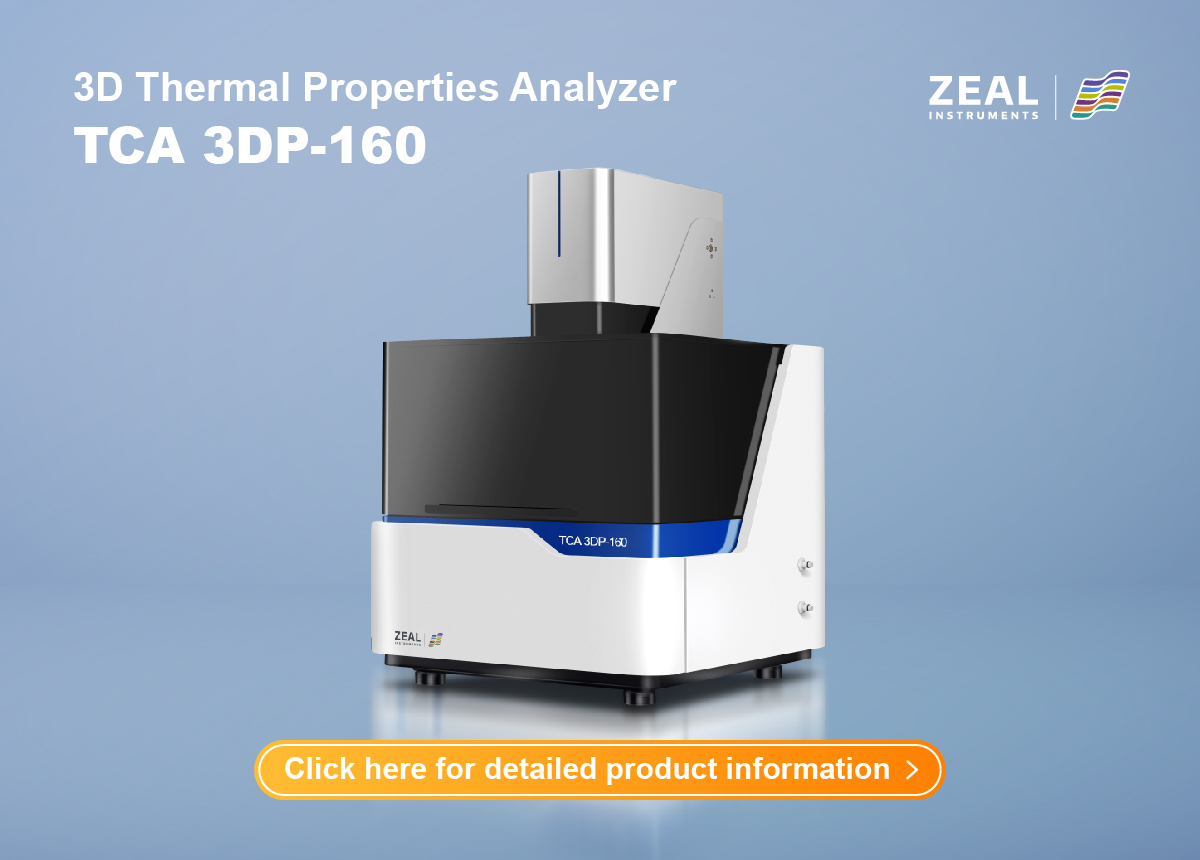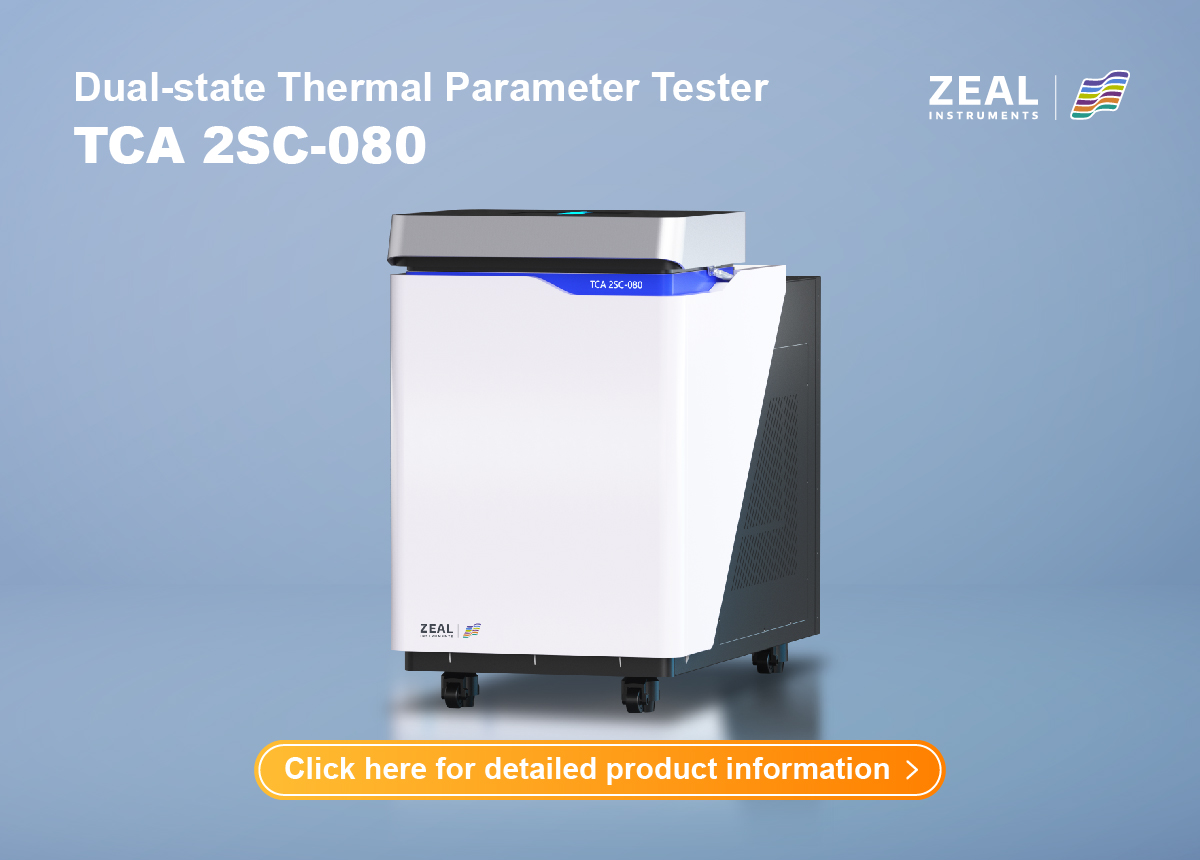In-Depth Insights: 3D Thermal Properties Analysis
With the rapid development of the new energy industry, lithium-ion batteries are widely used in electric vehicles and energy storage. To better prevent and control various thermal safety incidents, manufacturers and researchers need to conduct more in-depth studies on battery thermal runaway and thermal management characteristics. In the design and development of lithium battery thermal management, thermal simulation is a primary auxiliary development method and verification tool. Accurate thermal physical parameters are crucial for lithium battery thermal simulation. Among these, the thermal conductivity is one of the important thermal physical parameters of lithium batteries. Accurate measurement of the thermal conductivity of lithium batteries can aid in better development.
Traditional Methods: Steady-State and Transient Approaches
The mainstream methods for testing the thermal conductivity of pouch batteries can be divided into steady-state and transient methods. The steady-state approach, a traditional method, provides relatively accurate measurements of thermal conductivity. However, it requires high sample size, can only measure longitudinal thermal conductivity, and involves long testing times. On the other hand, transient methods have shorter testing times but are generally less accurate. The Hot Disk method, a widely used transient approach, faces criticism for poor experimental repeatability and inaccurate results, limiting the reliability of simulation models.
Innovative Solution: 3D Thermal Properties Analyzer
To address the issues associated with the Hot Disk method, we developed the 3D Thermal Properties Analyzer, utilizing infrared thermography and 3D data inversion technology. This instrument applies pulse excitation to the bottom of the pouch lithium battery using a flexible electric heating sheet. An infrared camera then measures temperature non-contactly on one side of the battery, allowing the calculation of both longitudinal and surface thermal conductivity through data inversion. This non-contact approach ensures accurate measurements, even for complex structured samples such as multi-layered, heterogeneous, or anisotropic materials.
Advanced Features and Capabilities
The 3D Thermal Properties Analyzer, model TCA 3DP-160, is designed for evaluating the thermal conductivity and thermal diffusivity of samples with complex structures. It accommodates a wide range of sample sizes with specific requirements for surface flatness. Its non-destructive testing capability allows accurate measurement of the equivalent thermal conductivity of multi-layer thin film stacks. The instrument is suitable for both homogeneous and heterogeneous samples of various specifications, including different surface hardness, roughness, and porosity.
The analyzer features uniform temperature control across six-sided cold plates, a high-precision oil bath temperature control, and adjustable ambient temperature settings. Non-contact measurement with automatic compensation for surface and support heat dissipation interferences enhances result accuracy. The instrument is simple to operate, with fully automated experiment initiation and execution. A color graphics display shows test data, predicted data, error data, and error assessment, enabling quick validation of experimental results. Additionally, the system automatically generates and saves graphs and process data, supporting historical data queries.
The 3D Thermal Properties Analyzer represents a significant advancement in accurately measuring thermal properties, addressing previous method limitations, and providing reliable data for the development and optimization of lithium batteries and other materials.
Specifications
1)Thermal Conductivity Range
The 3D Thermal Properties Analyzer can measure longitudinal thermal conductivity from 0.2 W/(m-K) to 5 W/(m-K) and transverse thermal conductivity from 5 W/(m-K) to 100 W/(m-K). This range allows for precise evaluation of different materials, including those with complex thermal properties.
2)Thermal Diffusivity Range
For thermal diffusivity, the analyzer measures longitudinal values from 0.1 mm²/s to 2 mm²/s and transverse values from 2 mm²/s to 50 mm²/s. This capability ensures accurate assessments of how quickly heat spreads through various materials.
3)Sample Size
The device accommodates transverse samples up to 400 mm × 250 mm and longitudinal samples between 3 mm and 20 mm. This flexibility supports the testing of a wide array of sample sizes, making it versatile for different applications.
4)Test Time
The analyzer delivers results in less than 10 minutes, significantly speeding up the testing process and improving efficiency in research and development settings.
5)Repeatability
With a repeatability rate of less than 3%, the analyzer ensures consistent and reliable results, crucial for validating experimental data and refining material properties.
6)Temperature Range and Stability
Operating within a temperature range of 0 to 60℃, the analyzer maintains a temperature stability of 0.03℃ and accuracy of 0.1℃. These features guarantee precise thermal measurements under controlled conditions.
More Thermal Conductivity Testing Products Recommendations
Thermal Conductivity Testing for Hard Shell Battery Cells
For hard shell battery cells, especially prismatic batteries with complex structures, there is no effective testing method without dismantling the outer shell. The industry often relies on empirical values or theoretical models for estimation. Given that prismatic batteries account for over 80% of installations in electric vehicles and energy storage sectors, developing thermal conductivity testing technology for prismatic batteries is crucial. Prismatic batteries are heterogeneous samples with a core-shell structure. The significant thermal conductivity difference between the internal roll core and the external aluminum shell, along with the shell’s thermal shielding effect, renders previous testing methods ineffective. Additionally, the contact thermal resistance between the roll core and the shell is critical for heat transfer and must be tested and evaluated simultaneously.
We have developed a “Heat Storage-Release” dual-state thermal parameter tester based on infrared thermography and 3D heat transfer model inversion. This device allows non-contact temperature measurement and accurate testing of the longitudinal and surface thermal conductivity of the roll core, as well as the contact thermal resistance between the roll core and the shell in a single experiment.
Dual-state Thermal Parameter Tester TCA 2SC-080: Specifications and Features
The TCA 2SC-080 is designed for evaluating heterogeneous core-shell structured samples. It provides non-destructive, in-situ measurements of multidimensional thermal conductivity for battery samples. The analyzer supports a wide range of sample sizes with low surface flatness requirements. It automatically sets experimental parameters based on sample information and adjusts during the test process. Suitable for both homogeneous and heterogeneous samples of various specifications, it uses a 3D heat transfer model for testing and inversion analysis. The device can measure parameters such as core transverse thermal conductivity, core longitudinal thermal conductivity, and overall equivalent thermal conductivity. It supports external battery charging and discharging equipment to simulate realistic thermal conditions. The TCA 2SC-080 features adjustable sample cold plate temperature and flow rate, uniform temperature across six-sided cold plates, high-precision oil bath temperature control, and adjustable ambient temperature. The instrument is simple to operate, with fully automated test initiation and execution.
- Test Parameters: The TCA 2SC-080 can measure core transverse and longitudinal thermal conductivity, core-shell contact thermal resistance, and overall equivalent thermal conductivity. These parameters provide a comprehensive understanding of the thermal properties of the battery cells.
- Sample and Test Specifications: The device accommodates a maximum sample size of 400mm x 250mm x 80mm and completes tests in less than 15 minutes. This efficiency makes it suitable for rapid testing in various research and industrial applications.
- Measurement Precision: The repeatability for core transverse thermal conductivity is less than 8%, and for core longitudinal thermal conductivity, it is less than 10%. The accuracy for overall equivalent transverse and longitudinal thermal conductivity is within 10%, ensuring reliable and consistent results.
- Temperature Control: The TCA 2SC-080 operates within a temperature range of 0 to 80℃, with a temperature stability of 0.03℃ and an accuracy of 0.1℃. These precise temperature control features enhance the reliability of thermal conductivity measurements.
Thermal Conductivity Testing for Insulation Materials
Insulation materials are essential for reducing heat transfer, with thermal conductivity being a key performance indicator. The heat flow method thermal conductivity meter (HFM) is typically used to measure this property. Known for its accuracy, speed, and ease of operation, the HFM works by placing the sample between two plates with different but constant temperatures. The heat flows from the hot plate through the sample to the cold plate due to the temperature difference.
Heat Flow Meter HFM 510A: Specifications and Features
The HFM 510A follows standards such as GB/T 10295, ASTM C518, and ISO 8301. It tests various low thermal conductivity materials, including expanded polystyrene, PU rigid foam, mineral wool, aerogel, and concrete. The device features high automation, with automatic heating plate adjustment, load force testing, thickness measurement, temperature control, and furnace door operation. Dual heat flow sensors enhance precision, while independent temperature control for the plates ensures accurate measurements.
The HFM 510A offers rapid and efficient sample testing. It adapts to uneven sample surfaces and includes molds for particle sample preparation, ensuring low preparation requirements. The software supports thermal conductivity extension accessory modes and offline operation for flexibility. It provides fully automated data collection, real-time monitoring, display, and automatic test report generation. The device also supports user login, historical record queries, and data storage and export customization.
- Operating Environment: The HFM 510A operates effectively in temperatures ranging from -5°C to 45°C and can function in environments with relative humidity of less than 95%.
- Temperature Control: The plate temperature range of the HFM 510A spans from -30°C to 90°C, maintained through an external refrigeration cooling system. The device employs a Peltier system for precise temperature control of the plates.
- Sample Specifications: The HFM 510A accommodates samples with a length and width of 300mm and heights up to 100mm. It can measure thermal resistance ranging from 0.1 m².K/W to 8 m².K/W and thermal conductivity from 0.002 W/(m-K) to 1 W/(m-K), with scalability up to 2 W/(m-K).
- Measurement Precision: The device boasts an accuracy of ±1% to 2% and repeatability of 0.5%. It applies a variable load force of 21 kPa (1930N) and measures thickness in the range of 0 to 100mm, with a resolution of 0.02mm.
Final Words
Accurately measuring thermal conductivity in lithium-ion batteries is crucial for advancing the new energy industry. With their extensive application in electric vehicles and energy storage, managing thermal properties effectively is essential to prevent safety incidents. Thermal simulation relies heavily on precise parameters like thermal conductivity, pivotal for optimizing battery performance. Traditional methods for pouch battery thermal conductivity measurement, such as steady-state and transient approaches, come with inherent limitations. Addressing these challenges, the 3D Thermal Properties Analyzer employs infrared thermography and advanced 3D data inversion. This cutting-edge tool enables non-contact temperature measurement and precise calculation of longitudinal and transverse thermal conductivity. It represents a significant leap forward in the accurate and efficient analysis of lithium-ion battery thermal behavior.








































